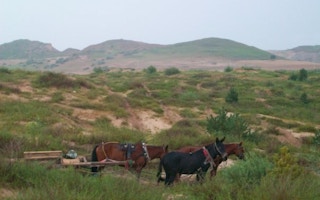Somewhere in Inner Mongolia, the next Tony Hawk skateboarding prodigy is waiting to be spawned. The local boys, clad in the universal tribal garb that marks twelve-to-fourteen-year-old boys (baggy t-shirts and shorts) are waggling on two-part skateboards that are more flexible than your typical one-piece deck. Think of them as “bikini skateboards” which have two lobes, joined by a brief metal hyphen, and each lobe has one wheel mounted on its underside. The wheels are blinged-out with little lights that flash red and green and blue, and the decks are skid proof and rubberized.
The boys are weaving in and out of each others paths, on the broad promenade that is the hallmark of post-Communist architecture: grand, sweeping, Soviet-style plazas and colonnades. Their mothers and sisters and maybe girlfriends are waiting for them patiently, wandering into shops that line the promenade, which sell clothing, snacks and sports equipment. This is a society that has leisure time, cash, and things like skateboards to spend that cash on.
And that’s just the small city, Ganqika. Small, of course, is relative. The population of Ganqika being about seventy thousand people, all consuming, consuming, consuming.
Out in the countryside, the story is the same. The roads are a trifle bumpy, and their condition apparently changes annually, or even seasonally. And along the roads, mounted on nearly every mud-and-brick hut in every village is that global motif of development: the satellite dish, bringing Chinese-language television programmes from Shanghai, Taiwan, even distant Singapore.
Formerly, the people of Inner Mongolia made their living by riding and herding, with some agriculture thrown into the mix. Development has enabled them to farm intensively, ride skateboards and watch television. But development, in the form of overgrazing, overpopulation and agriculture have taxed the land; Inner Mongolia’s population has quadrupled to about 24 million, and the number of sheep, cows and goats has shot up in tandem. Two of China’s largest firms in its nascent dairy industry - Yili and Mengniu - are in the autonomous region.
The result of all this is desertification. It’s the same sad story: land is grazed or cleared for mono-cultures of corn or millet or sunflowers. Sun and wind strip the top layers of exposed soil, the soil loses water, and the land is left less fertile.
Then, there are the ferocious dust storms that sandblast the region in spring, blowing as far as Japan or Korea and grounding flights for lack of visibility. Even in the off-season, the wind carries fine grit that gets into eyes and leaves faint scratches on skin. If ever one needed an illustration of man-made climate change on a human time scale, this is it.
Against this backdrop, NGOs and governments are struggling to reverse that desertification. The NGO in this part of town is a Japanese organisation called Green Network, which was started in 2000 to plant trees and shrubs in Inner Mongolia’s Horqin desert - an area 56 times the size of Singapore.
The roots of sea buck thorn and other shrubs grip the soil, and rows of tall pines and poplars serve as windbreaks. The landscape, and latitudes, are roughly that of North Dakota or middle Canada.
Green Network operates in tandem with Chinese and Japanese universities, and has corporate sponsors like electronics giant Hitachi and United States outdoor apparel brand Timberland. It also works with local communities to water, prune and maintain the reforested areas, and educates them on sustainable agricultural practices.
Yoshio Kitaura, the wild-haired co-founder who resembles a cross between an Appalachian through-hiker and young Japanese Prime Minister Junichiro Koizumi, demonstrates how saving a field from sheep grazing has rescued it from turning to sand. Green Network adopts this show-not-tell tack, he explains, because suspicious villagers used to chase them off the land. Now, the villagers are inviting the NGO to plant trees and share knowledge.
To date, Japanese and local employees of Green Network have planted about 3.9 million native trees, as well as other shrubs. Once there are shrubs and saplings, the soil does not remain bare for long; wind-blown and animal-transported grasses soon take over. Though only half the trees manage to grow in the harsh climate, the surviving plants help to lessen the sandstorms’ intensity.
Desertification here is an example of climate change that humans have set in motion. With conscious, restrained growth, it could have been prevented from even occurring in the first place. But just as people have triggered it, people may yet be able to halt its deterioration. The reforestation efforts here are one example. Of course, there are challenges both local and global. For instance, the government has lent the land to Green Network for a period of ten years, and its tenure in some spots runs out next year. Local residents have to continue to manage the land. Will they bring the herds back to graze? Will they let the land lie fallow between grazing? As China faces its worst drought in sixty years, will they farm more intensively to make up for the food shortfall caused by the droughts? Environmental awareness is slowly taking root amongst China’s urban dwellers, says its World Wide Fund for Nature (WWF) country representative, Dermot O’Gorman. In fact, paradoxically, the more urbanised it gets, the more interest there is in biodiversity and conservation. That’s because city folk don’t encounter wildlife or nature on a daily basis; consequently, they place a higher value on it and have much more interest in saving it.
Conservation is not incompatible with skateboards, satellite dishes and outlet shops, if it is planned for a sustainable future. But it remains to be seen how rural dwellers will act - and whether they will take the long term view.










